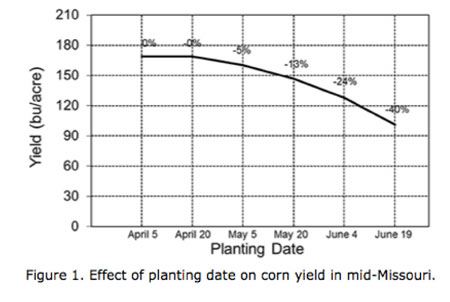Planting Date 2013
DR. BRENT MYERS
COLUMBIA, MO.
Because of frequent and heavy rain, corn
planting in Missouri has been much slower
this year than last year. But, last year was
an odd year in nearly every way, including unusually
warm and dry March weather. For
many reasons, we ought to put 2012 in our rear
view mirror and not look back for much help in
making crop management decisions. For example,
37 percent of Missouri’s corn acreage was
planted by April 14, 2012. Short term normal (5
years) was only 17 percent, and nearly all of
that 17 percent occurs in the southern part of
our state.
This year, Missouri’s corn planting progress is
8 percent – slower than normal, but no reason
for alarm, yet. Figure 1 presents the effect of
planting date on corn yield for mid-Missouri.
Data are averaged over five years and at least
four hybrids in each year. Our data indicate, on
average, little difference in yield potential for
planting dates in April. From May 1 to June 1
corn yields decrease about 25 percent.
As you might guess, differences occur among
years for response of corn yield to planting date.
Weather conditions in July and early August affect
corn yield far more than planting date and
weather during those weeks can mask the effect
of planting date. For this reason, it is difficult to
predict in any specific year what will happen to
corn yield if planting is delayed. However, on average,
corn yield potential declines during May,
first slowly, but then at an increasing rate toward
the end of the month.
The costs and benefits of switching corn
acreage to another crop such as soybean vary
among farmers and fields. Each farmer must
make the decisions for which he/she is comfortable.
But, our data indicate that switching
out of corn may not be wise even if planting is
delayed until the end of May.

Although not part of the data in Figure 1, it
may not make sense to switch corn maturities,
either. We found that corn hybrids with CRM of
110 out yielded corn hybrids with CRM of 100
until the first week of June. Early maturing hybrids
are short, have shorter kernel-filling periods,
and should be planted at greater seeding
rates. We understand that drying costs are important,
and our data focuses solely on yield
comparisons.
Our data provide some optimism that reasonably
high yield can be obtained when corn is
planted in mid to late May. However, yield potential
is very strongly dependent on weather
conditions in summer. The ability for corn to
maintain yield in years with dry weather is
strongly related to the health of the root system.
While it is understandable that planting may
begin too soon as soils begin to dry, planting
and other traffic on wet soils lead to soil compaction.
Soil compaction reduces root growth
and may result in increased disease incidence.
So, once soil has begun to dry, patience is
needed so that harm to developing corn roots is
minimized. Δ
DR. WILLIAM J. WIEBOLD: Professor/Division
of Plant Sciences, University of Missouri
DR. BRENT MYERS: Assistant Professor/Division
of Plant Sciences, University of Missouri